News-nezota.cc ads (spam) - Free Guide
News-nezota.cc ads Removal Guide
What is News-nezota.cc ads?
News-nezota.cc is a dubious website disguised as a human verification step
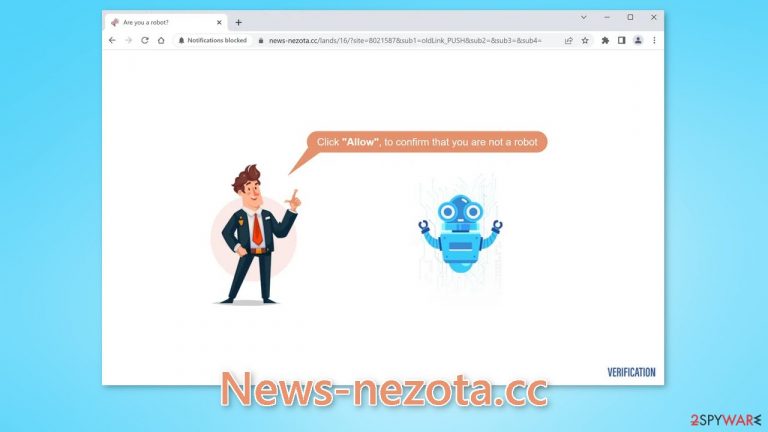
News-nezota.cc is a fraudulent website operated by con artists. It uses social engineering[1] techniques to persuade people to subscribe to push notifications. Users are asked to confirm that they are not robots by clicking the “Allow” button. However, as a result of this action, spam is generated.
Even if you close your web browser, those annoying pop-up ads can still appear on your screen. Unfortunately, scammers may employ rogue advertising networks to place advertisements that lead to dangerous websites. People may end up on pages that attempt to steal personal information and trick them into installing PUPs (potentially unwanted programs)[2] or even malware.
Users have reported seeing ads for adult websites, bogus antivirus offers, software deals, surveys, and freebies. As a result, it is critical to disable the advertisements as soon as possible, especially if other people are using the affected machine. All of the necessary instructions are provided below.
| NAME | News-nezota.cc |
| TYPE | Push notification spam; adware |
| SYMPTOMS | Pop-up ads start appearing in the corner of the screen sometimes even when the browser is closed |
| DISTROBUTION | Shady websites; deceptive ads; bundled software |
| DANGERS | Links embedded in the pop-ups can lead to dangerous websites where people might get tricked into providing their personal information or downloading PUPs and malware |
| ELIMINATION | To disable push notifications go to your browser settings |
| FURTHER STEPS | Use FortectIntego to clear your browsers and fix performance issues |
Distribution methods
We previously discussed many other pop-up spam websites, such as Buygadsgroup.com, Rabonoldize.com, Porptogred.com, and others. You're probably wondering where all of these push notification spam pages that seem to be popping up everywhere lately are coming from. They are usually concealed on other shady websites.
These websites are rife with shady ads and sneaky redirects. An example would be illegal streaming sites that display bogus “Download” and “Play” buttons that, in theory, should direct users to the desired content but instead redirect them to new pages that monetize user activity.
To avoid being taken advantage of, only visit websites that you are familiar with when browsing the internet. Do not click on links or advertisements from unknown sources because they could be bait used by crooks to trick you. To be safe, it is best to go straight to the source.

How to block push notifications?
Because push notifications are based on a subscription model, users need to disable them manually. If you do not know how, here are the instructions for Google Chrome, Mozilla Firefox, Safari, MS Edge:
Google Chrome (desktop):
- Open Google Chrome browser and go to Menu > Settings.
- Scroll down and click on Advanced.
- Locate the Privacy and security section and pick Site Settings > Notifications.
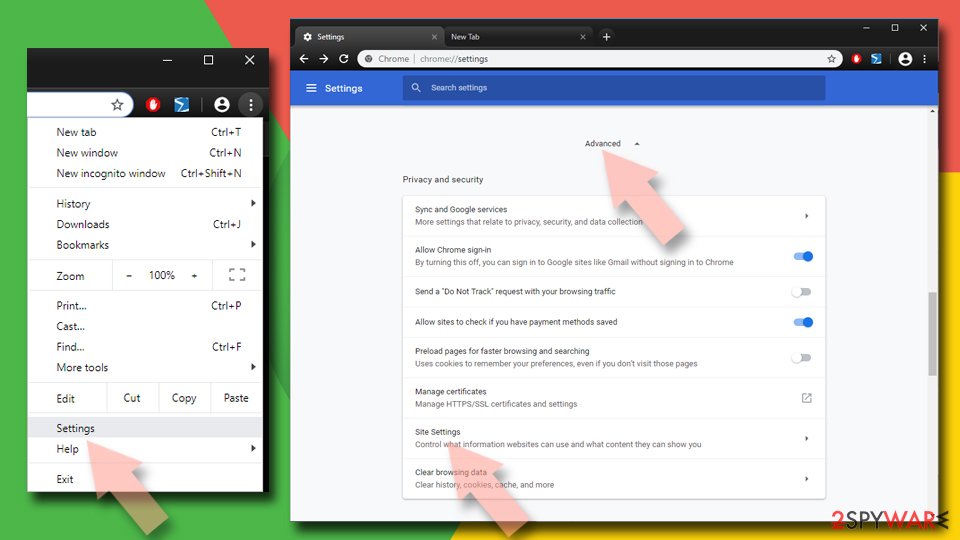
- Look at the Allow section and look for a suspicious URL.
- Click the three vertical dots next to it and pick Block. This should remove unwanted notifications from Google Chrome.
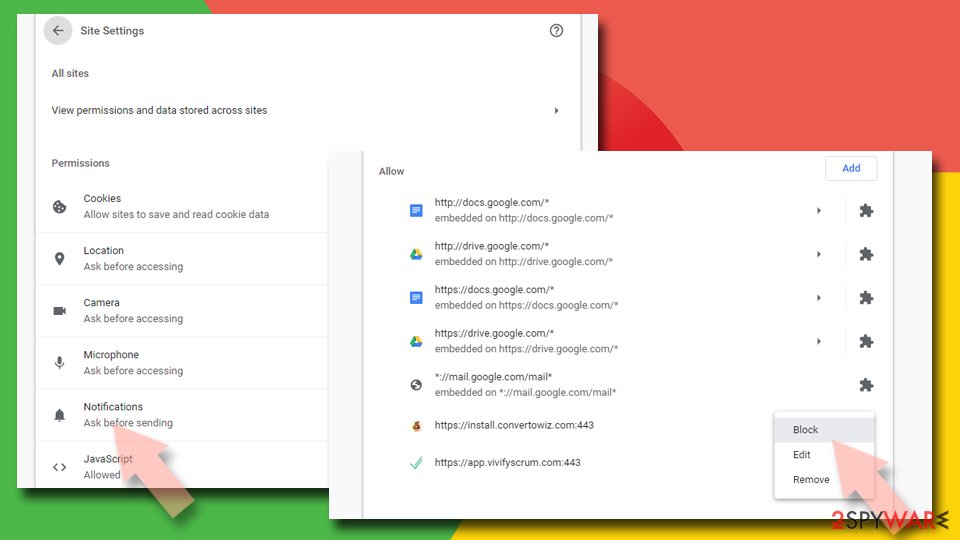
Google Chrome (Android):
- Open Google Chrome and tap on Settings (three vertical dots).
- Select Notifications.
- Scroll down to Sites section.
- Locate the unwanted URL and toggle the button to the left (Off setting).
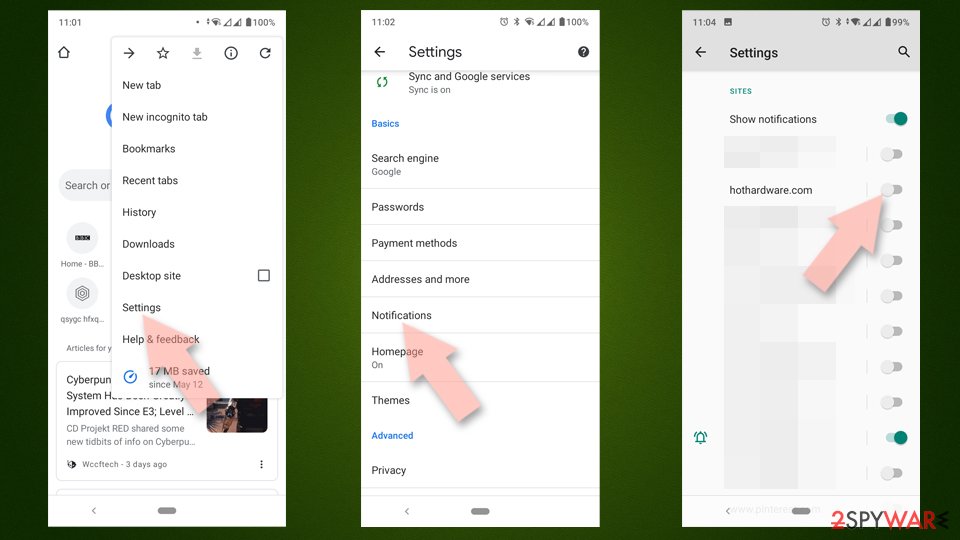
Mozilla Firefox:
- Open Mozilla Firefox and go to Menu > Options.
- Click on Privacy & Security section.
- Under Permissions, you should be able to see Notifications. Click Settings button next to it.
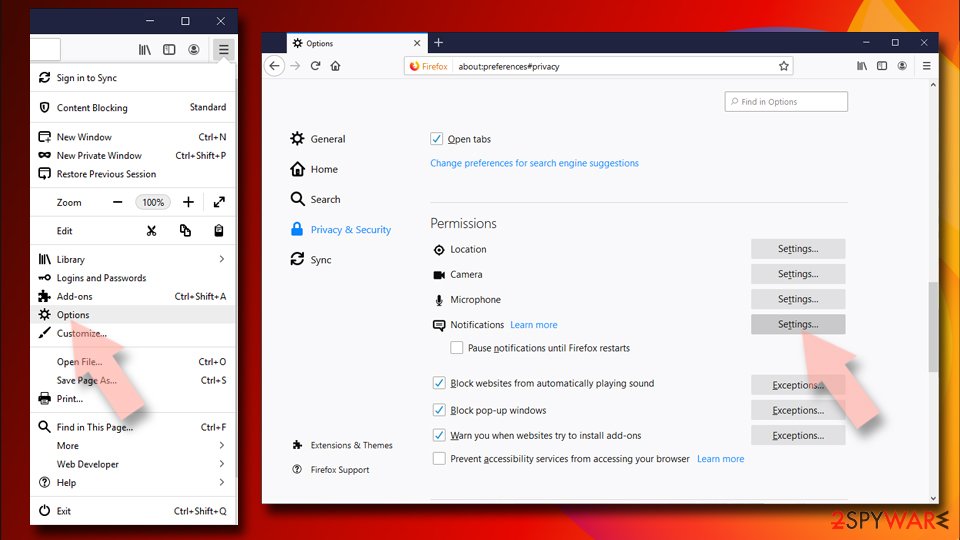
- In the Settings – Notification Permissions window, click on the drop-down menu by the URL in question.
- Select Block and then click on Save Changes. This should remove unwanted notifications from Mozilla Firefox.
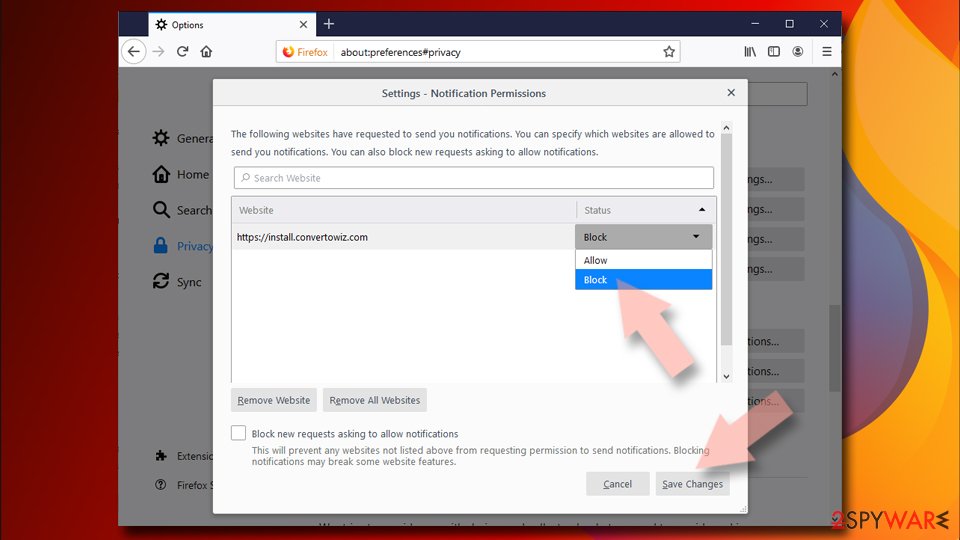
Safari:
- Click on Safari > Preferences…
- Go to Websites tab and, under General, select Notifications.
- Select the web address in question, click the drop-down menu and select Deny.
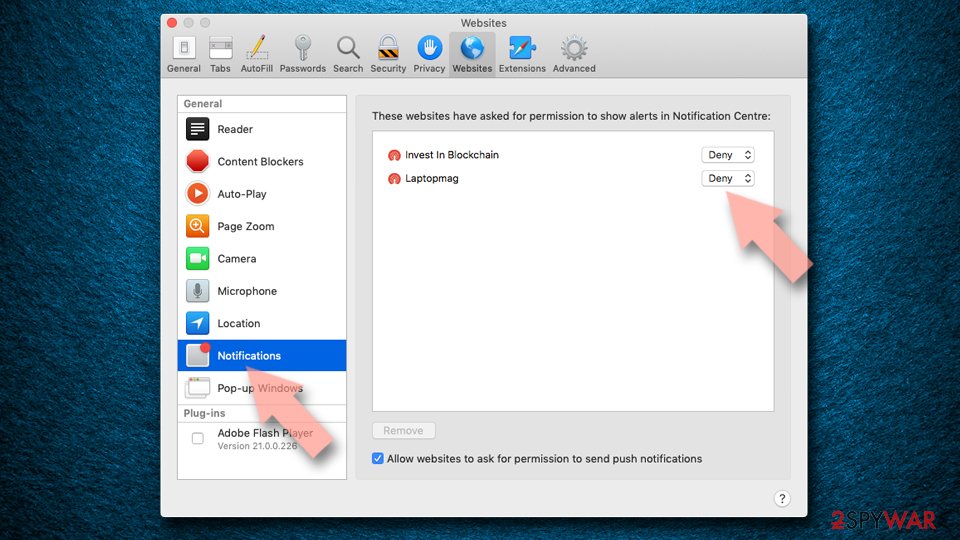
MS Edge:
- Open Microsoft Edge, and click the Settings and more button (three horizontal dots) at the top-right of the window.
- Select Settings and then go to Advanced.
- Under Website permissions, pick Manage permissions and select the URL in question.
- Toggle the switch to the left to turn notifications off on Microsoft Edge.
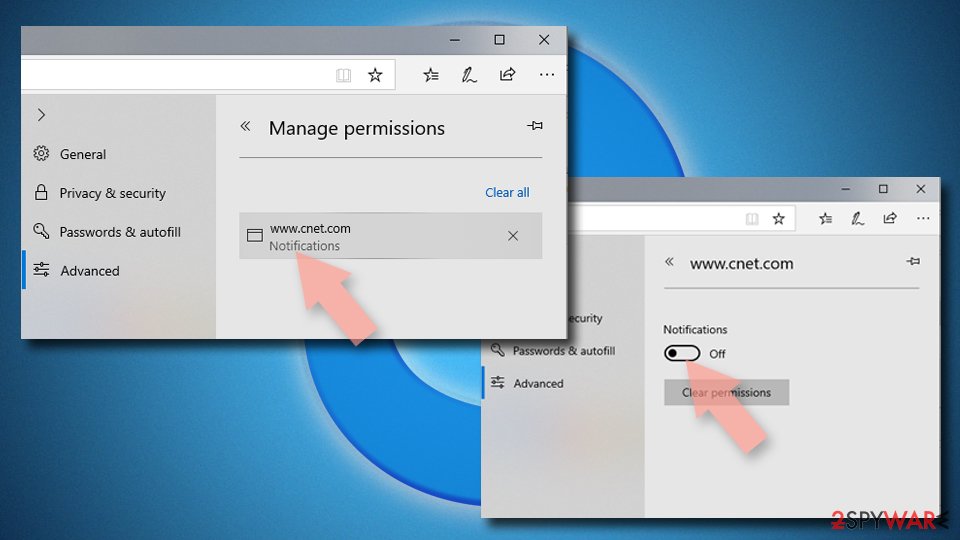
MS Edge (Chromium):
- Open Microsoft Edge, and go to Settings.
- Select Site permissions.
- Go to Notifications on the right.
- Under Allow, you will find the unwanted entry.
- Click on More actions and select Block.
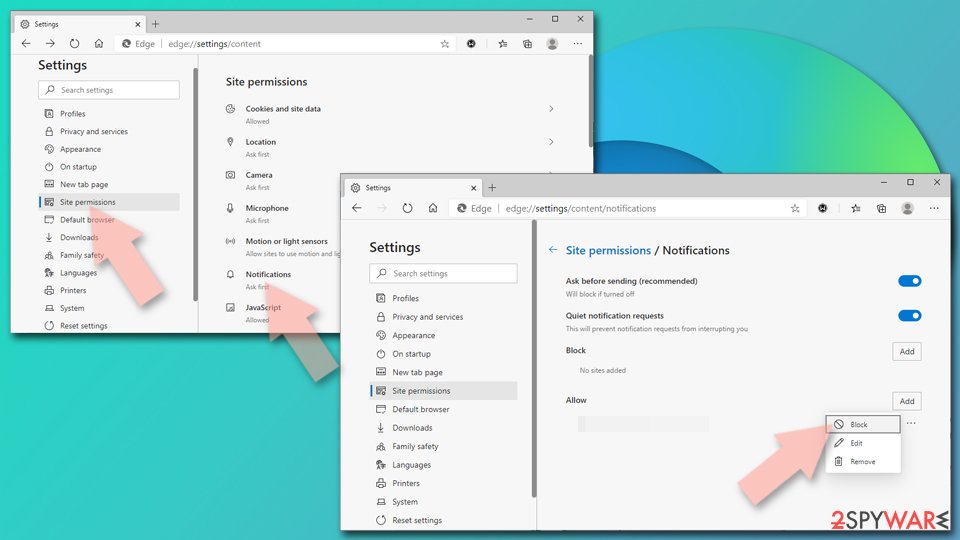
Cookies and cache
If you've noticed an increase in pop-up spam recently, it's probably because you visited some dubious websites that are still tracking your activity. Almost every website now requires visitors to accept cookies, so be cautious about which pages you visit in the future. Cookies save information like which websites you visit, which links you click on, your search history, and what you buy online.
Without your knowledge, this data may be sold to advertising networks or other third parties. To automatically clear your browser's cookies and cache, free up space on your device, repair corrupted files, and optimize performance, we recommend using a repair tool like FortectIntego.
Scan your system for adware
There may be a possibility that you are infected with adware[3] and that is why you are constantly bombarded with ads. Because there is no way of knowing which specific app is causing this annoying behavior, we always suggest our readers use professional security tools like SpyHunter 5Combo Cleaner or Malwarebytes to scan their PCs.
Anti-malware tools can detect suspicious programs that are active in the background and eliminate them completely with all the related files. Manual removal may result in the renewal of infection as people often fail to eliminate all the related files and entries, however, if you still want to do this yourself, you can follow the guide below for Windows and Mac machines.
Windows 10/8:
- Enter Control Panel into Windows search box and hit Enter or click on the search result.
- Under Programs, select Uninstall a program.

- From the list, find the entry of the suspicious program.
- Right-click on the application and select Uninstall.
- If User Account Control shows up, click Yes.
- Wait till uninstallation process is complete and click OK.

Windows 7/XP:
- Click on Windows Start > Control Panel located on the right pane (if you are Windows XP user, click on Add/Remove Programs).
- In Control Panel, select Programs > Uninstall a program.

- Pick the unwanted application by clicking on it once.
- At the top, click Uninstall/Change.
- In the confirmation prompt, pick Yes.
- Click OK once the removal process is finished.
Mac:
- From the menu bar, select Go > Applications.
- In the Applications folder, look for all related entries.
- Click on the app and drag it to Trash (or right-click and pick Move to Trash)

To fully remove an unwanted app, you need to access Application Support, LaunchAgents, and LaunchDaemons folders and delete relevant files:
- Select Go > Go to Folder.
- Enter /Library/Application Support and click Go or press Enter.
- In the Application Support folder, look for any dubious entries and then delete them.
- Now enter /Library/LaunchAgents and /Library/LaunchDaemons folders the same way and terminate all the related .plist files.

How to prevent from getting adware
Do not let government spy on you
The government has many issues in regards to tracking users' data and spying on citizens, so you should take this into consideration and learn more about shady information gathering practices. Avoid any unwanted government tracking or spying by going totally anonymous on the internet.
You can choose a different location when you go online and access any material you want without particular content restrictions. You can easily enjoy internet connection without any risks of being hacked by using Private Internet Access VPN.
Control the information that can be accessed by government any other unwanted party and surf online without being spied on. Even if you are not involved in illegal activities or trust your selection of services, platforms, be suspicious for your own security and take precautionary measures by using the VPN service.
Backup files for the later use, in case of the malware attack
Computer users can suffer from data losses due to cyber infections or their own faulty doings. Ransomware can encrypt and hold files hostage, while unforeseen power cuts might cause a loss of important documents. If you have proper up-to-date backups, you can easily recover after such an incident and get back to work. It is also equally important to update backups on a regular basis so that the newest information remains intact – you can set this process to be performed automatically.
When you have the previous version of every important document or project you can avoid frustration and breakdowns. It comes in handy when malware strikes out of nowhere. Use Data Recovery Pro for the data restoration process.
- ^ Cynthia Gonzalez. Top 8 Social Engineering Techniques and How to Prevent Them [2022]. Exabeam. Information Security.
- ^ Chris Hoffman. PUPs Explained: What is a “Potentially Unwanted Program”?. Howtogeek. Technology Magazine.
- ^ Adware. Malwarebytes. Cybersecurity Basics.
